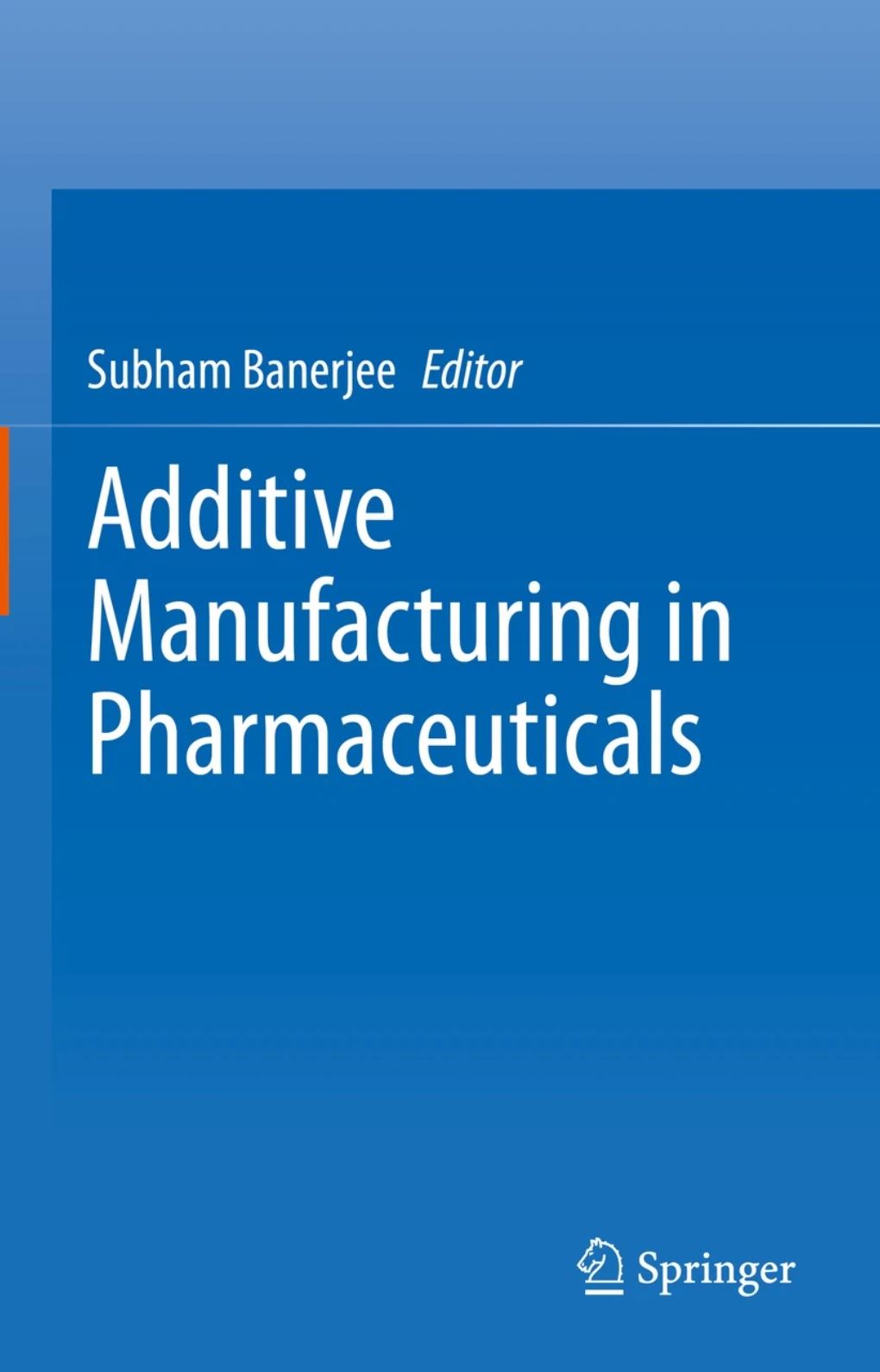Additive Manufacturing in Pharmaceuticals – Part 1

Additive Manufacturing in Pharmaceuticals
See the new book, edited by Dr. Subham Banerjee, Ph.D., Associate Professor in the Department of Pharmaceutics, National Institute of Pharmaceutical Education & Research (NIPER), Guwahati, Assam, India.
Description: This book presents the different 3D/4D printing technological applications of Additive Manufacturing (AM) in Pharmaceutical Sciences. The initial chapter provides the historical perspective and current scenario of AM in pharmaceuticals. The book further discusses about different 3D printing platform technologies such as FDM, SLA, SLS, SSE, Ink-jet & binder jet principles & applications in developing advanced drug delivery systems. It also covers the methodology, materials for AM and important parameters associated with these platform technologies. The book highlights the progress and practical applications of 4D-printing technology in healthcare & pharmaceuticals fraternity as well including the essence of bioprinting in pharmaceuticals. Finally, the book reviews the regulatory guidelines, perspectives, and integration of Artificial Intelligence (AI)/Machine learning (ML) in pharmaceutical AM. This book is indeed a valuable resource for students, researchers/scholars, young start-ups/entrepreneurs, and pharmaceutical professionals by providing thorough detailing about AM in Pharmaceuticals.
Chapter 1
History and Present Scenario of Additive Manufacturing in Pharmaceuticals
Additive manufacturing also called 3D printing has provided a personalization front to the pharmaceutical industry where dosage development can be patient centric. If needed, 3D printed dosage form can be formulated with customized shape, size, and release characteristics on the patient bedside. Hailing from rapid prototyping and into biomedical field, 3D printing has convincingly revolutionized pharmaceutical industry and its pace of innovation. 3D printing empowers the formulation design to new directions such as personalized medicine, controlled released dosage form, organ on a chip, as well as implants. Even until few years ago, it was implausible to foresee the adoption of 3D printing to formulation development pipeline such as preformulation to First-in-Human (FIH). And now, 3D printing is being investigated to be used in front line clinical trial setting to provide personalized service to the trial patients. Around 30,000 articles in technological literature have already been published discussing the futuristic application of 3D printing in pharmaceutical field. The rapid progression of 3D printing in the pharmaceutical field is a result of an extensive amount of past research, driven by its vast application potential. Hence, this chapter encapsulates the past and the present status of 3D printing in pharmaceuticals with an open-ended future application possibility.
Sen, K., West, T.G., Chaudhuri, B. (2023). History and Present Scenario of Additive Manufacturing in Pharmaceuticals. In: Banerjee, S. (eds) Additive Manufacturing in Pharmaceuticals. Springer, Singapore. https://doi.org/10.1007/978-981-99-2404-2_1
Chapter 2
Fused Deposition Modeling (FDM) of Pharmaceuticals
A shift in treatment strategy from generalized to personal healthcare has sparked the interest for flexible production techniques capable of producing patient-specific dosage forms. Fused deposition modeling could be utilized for such personalized treatment, and its interest has grown rapidly, with over 350 published papers in the field of pharmaceutical science in the last decade. The advantages of the technique are indeed manifold. Apart from being desktop-sized, FDM has also been praised for its simplicity and cost-effectiveness. The aim of this chapter is to summarize 10 years of research on pharmaceutical FDM 3D-printing in a concise and comprehensive way. Therefore, this chapter first provides information about the FDM 3D-printing equipment and its process mechanism. Next, the typical formulation constituents and specific characterization techniques for the printed dosage forms will be discussed. Finally, a variety of possible pharmaceutical applications like oral therapies, transdermal or transmucosal films and implants will also be reviewed.
Henry, S., Vanhoorne, V., Vervaet, C. (2023). Fused Deposition Modeling (FDM) of Pharmaceuticals. In: Banerjee, S. (eds) Additive Manufacturing in Pharmaceuticals. Springer, Singapore. https://doi.org/10.1007/978-981-99-2404-2_2
Chapter 4
Selective Laser Sintering (SLS) in Pharmaceuticals
Rapidly developing and evolving rapid prototyping technologies and the emergence of 3D printable materials integrated with drug moieties have enormous potential in the customization of dosage forms required for patients. Feature-rich functionalities of solid dosage forms such as desired control over porous internal architecture, complex geometry, and wide varieties of possible shapes and size, which are very difficult to achieve with mass manufacturing, are now possible with Selective Laser Sintering (SLS) mediated rapid prototyping. SLS-mediated 3D printing technology is the powder bed fusion technology that provides control over the release pattern of the drug incorporated in the dosage form in terms of immediate or controlled as well as the sustained release of the drug. This can be easily achieved using appropriate matrix-forming agents from a wide range of processable polymers and fine-tuning of various process parameters. An added benefit of this powder bed fusion technology is that, it allows the fabrication of any solid oral dosage form in just a single step without use of any solvent, which turns this technique of rapid prototyping into green technology. Thus, the purpose of this chapter is to discuss basic fundaments of SLS, its potential pharmaceutical applications along with diverse processable materials, essential process parameters and their effect on SLS-mediated fabrication, setbacks for scale-up, regulatory consideration, and future aspects of SLS-mediated 3D printing in pharmaceuticals.
Karanwad, T., Lekurwale, S., Banerjee, S. (2023). Selective Laser Sintering (SLS) in Pharmaceuticals. In: Banerjee, S. (eds) Additive Manufacturing in Pharmaceuticals. Springer, Singapore. https://doi.org/10.1007/978-981-99-2404-2_4
See the full book here
Dr. Subham Banerjee, Ph.D., Additive Manufacturing in Pharmaceuticals, Hardcover ISBN 978-981-99-2403-5, Published: 14 September 2023, eBook ISBN 978-981-99-2404-2, Published: 13 September 2023, DOI https://doi.org/10.1007/978-981-99-2404-2
There will be to additional articles here soon with the remaining book chapter contents:

